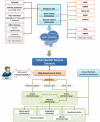Indian genetic disease database
- PMID: 21037256
- PMCID: PMC3013653
- DOI: 10.1093/nar/gkq1025
Indian genetic disease database
Abstract
Indians, representing about one-sixth of the world population, consist of several thousands of endogamous groups with strong potential for excess of recessive diseases. However, no database is available on Indian population with comprehensive information on the diseases common in the country. To address this issue, we present Indian Genetic Disease Database (IGDD) release 1.0 (http://www.igdd.iicb.res.in)--an integrated and curated repository of growing number of mutation data on common genetic diseases afflicting the Indian populations. Currently the database covers 52 diseases with information on 5760 individuals carrying the mutant alleles of causal genes. Information on locus heterogeneity, type of mutation, clinical and biochemical data, geographical location and common mutations are furnished based on published literature. The database is currently designed to work best with Internet Explorer 8 (optimal resolution 1440 × 900) and it can be searched based on disease of interest, causal gene, type of mutation and geographical location of the patients or carriers. Provisions have been made for deposition of new data and logistics for regular updation of the database. The IGDD web portal, planned to be made freely available, contains user-friendly interfaces and is expected to be highly useful to the geneticists, clinicians, biologists and patient support groups of various genetic diseases.
Figures
References
-
- Sipilä K, Aula P. Database for the mutations of the Finnish disease heritage. Hum. Mutat. 2002;19:16–22. - PubMed
-
- Kleanthous M, Patsalis PC, Drousiotou A, Motazacker M, Christodoulou K, Cariolou M, Baysal E, Khrizi K, Moghimi B, Pourfarzad F, et al. The cypriot and Iranian national mutation frequency databases. Hum. Mutat. 2006;27:598–599. - PubMed
-
- Patrinos GP, van Baal S, Petersen MB, Papadakis MN. Hellenic National Mutation database: a prototype database for mutations leading to inherited disorders in the Hellenic population. Hum. Mutat. 2005;25:327–333. - PubMed
-
- Zlotogora J, van Baal S, Patrinos GP. Documentation of inherited disorders and mutation frequencies in the different religious communities in Israel in the Israeli National Genetic Database. Hum. Mutat. 2007;28:944–949. - PubMed
-
- Megarbane A, Chouery E, van Baal S, Patrinos GP. The Lebanese National Mutation Frequency database. Eur. J. Hum. Genet. 2006;(Suppl. 1):65.
Publication types
MeSH terms
LinkOut - more resources
Full Text Sources
Other Literature Sources
Medical



